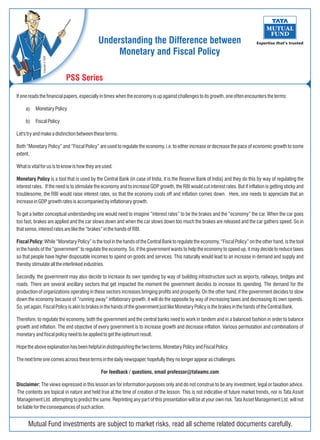Weitere ähnliche Inhalte
Ähnlich wie Pss series difference between monetary & fiscal policy 13th august 2012
Ähnlich wie Pss series difference between monetary & fiscal policy 13th august 2012 (16)
Mehr von Prof. Simply Simple
Mehr von Prof. Simply Simple (20)
Pss series difference between monetary & fiscal policy 13th august 2012
- 1. Understanding the Difference between
Monetary and Fiscal Policy
Copyright © 2009
PSS Series
If one reads the financial papers, especially in times when the economy is up against challenges to its growth, one often encounters the terms:
a) Monetary Policy
b) Fiscal Policy
Let's try and make a distinction between these terms.
Both “Monetary Policy” and “Fiscal Policy” are used to regulate the economy, i.e. to either increase or decrease the pace of economic growth to some
extent.
What is vital for us is to know is how they are used.
Monetary Policy is a tool that is used by the Central Bank (in case of India, it is the Reserve Bank of India) and they do this by way of regulating the
interest rates. If the need is to stimulate the economy and to increase GDP growth, the RBI would cut interest rates. But if inflation is getting sticky and
troublesome, the RBI would raise interest rates, so that the economy cools off and inflation comes down. Here, one needs to appreciate that an
increase in GDP growth rates is accompanied by inflationary growth.
To get a better conceptual understanding one would need to imagine “interest rates” to be the brakes and the “economy” the car. When the car goes
too fast, brakes are applied and the car slows down and when the car slows down too much the brakes are released and the car gathers speed. So in
that sense, interest rates are like the “brakes” in the hands of RBI.
Fiscal Policy: While “Monetary Policy” is the tool in the hands of the Central Bank to regulate the economy, “Fiscal Policy” on the other hand, is the tool
in the hands of the “government” to regulate the economy. So, if the government wants to help the economy to speed up, it may decide to reduce taxes
so that people have higher disposable incomes to spend on goods and services. This naturally would lead to an increase in demand and supply and
thereby stimulate all the interlinked industries.
Secondly, the government may also decide to increase its own spending by way of building infrastructure such as airports, railways, bridges and
roads. There are several ancillary sectors that get impacted the moment the government decides to increase its spending. The demand for the
production of organizations operating in these sectors increases bringing profits and prosperity. On the other hand, if the government decides to slow
down the economy because of “running away” inflationary growth, it will do the opposite by way of increasing taxes and decreasing its own spends.
So, yet again, Fiscal Policy is akin to brakes in the hands of the government just like Monetary Policy is the brakes in the hands of the Central Bank.
Therefore, to regulate the economy, both the government and the central banks need to work in tandem and in a balanced fashion in order to balance
growth and inflation. The end objective of every government is to increase growth and decrease inflation. Various permutation and combinations of
monetary and fiscal policy need to be applied to get the optimum result.
Hope the above explanation has been helpful in distinguishing the two terms, Monetary Policy and Fiscal Policy.
The next time one comes across these terms in the daily newspaper, hopefully they no longer appear as challenges.
For feedback / questions, email professor@tataamc.com
Disclaimer: The views expressed in this lesson are for information purposes only and do not construe to be any investment, legal or taxation advice.
The contents are topical in nature and held true at the time of creation of the lesson. This is not indicative of future market trends, nor is Tata Asset
Management Ltd. attempting to predict the same. Reprinting any part of this presentation will be at your own risk. Tata Asset Management Ltd. will not
be liable for the consequences of such action.
Mutual Fund investments are subject to market risks, read all scheme related documents carefully.

